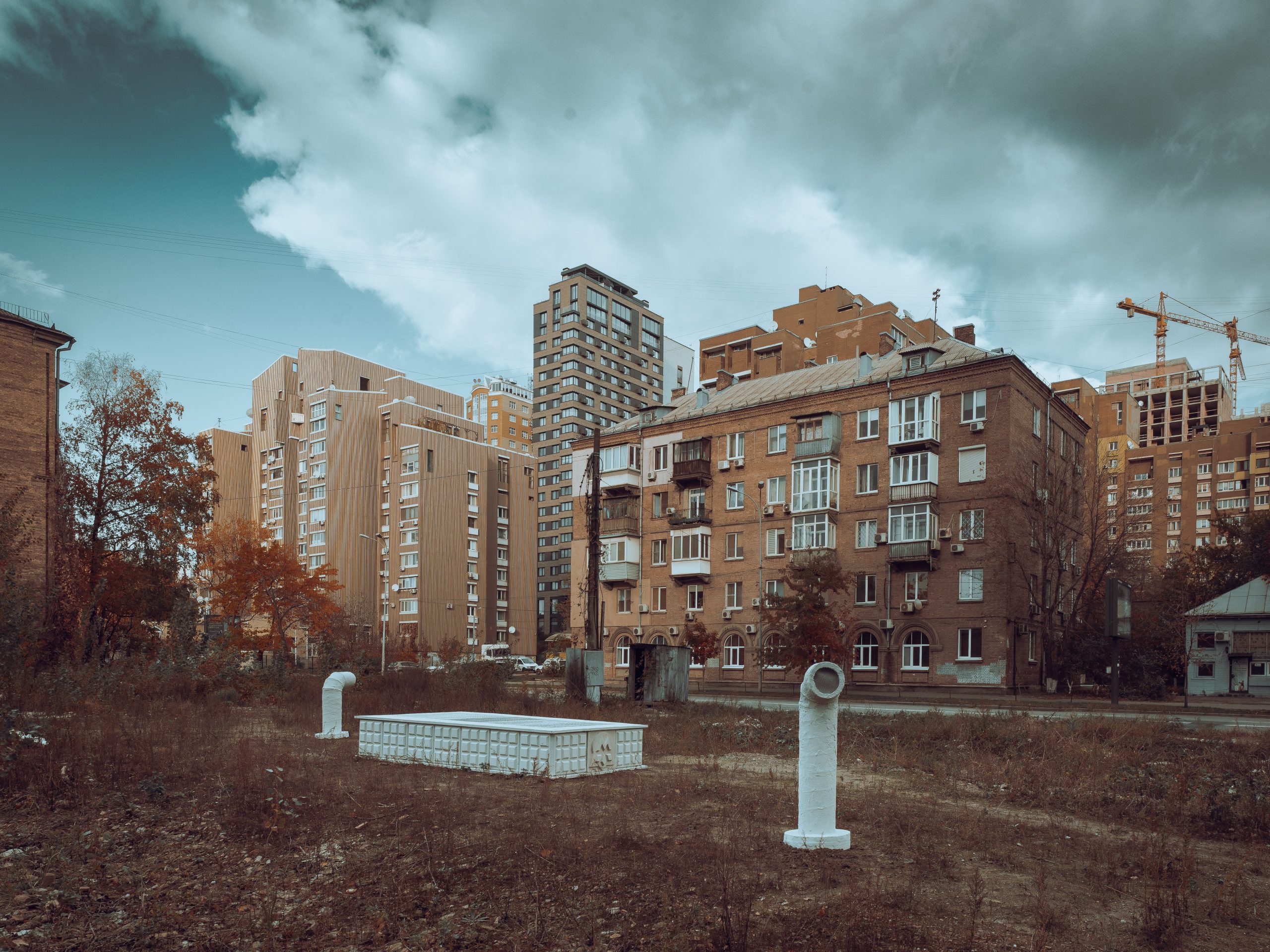
THE KYIV BERLIN METRO CONSTRUCTION
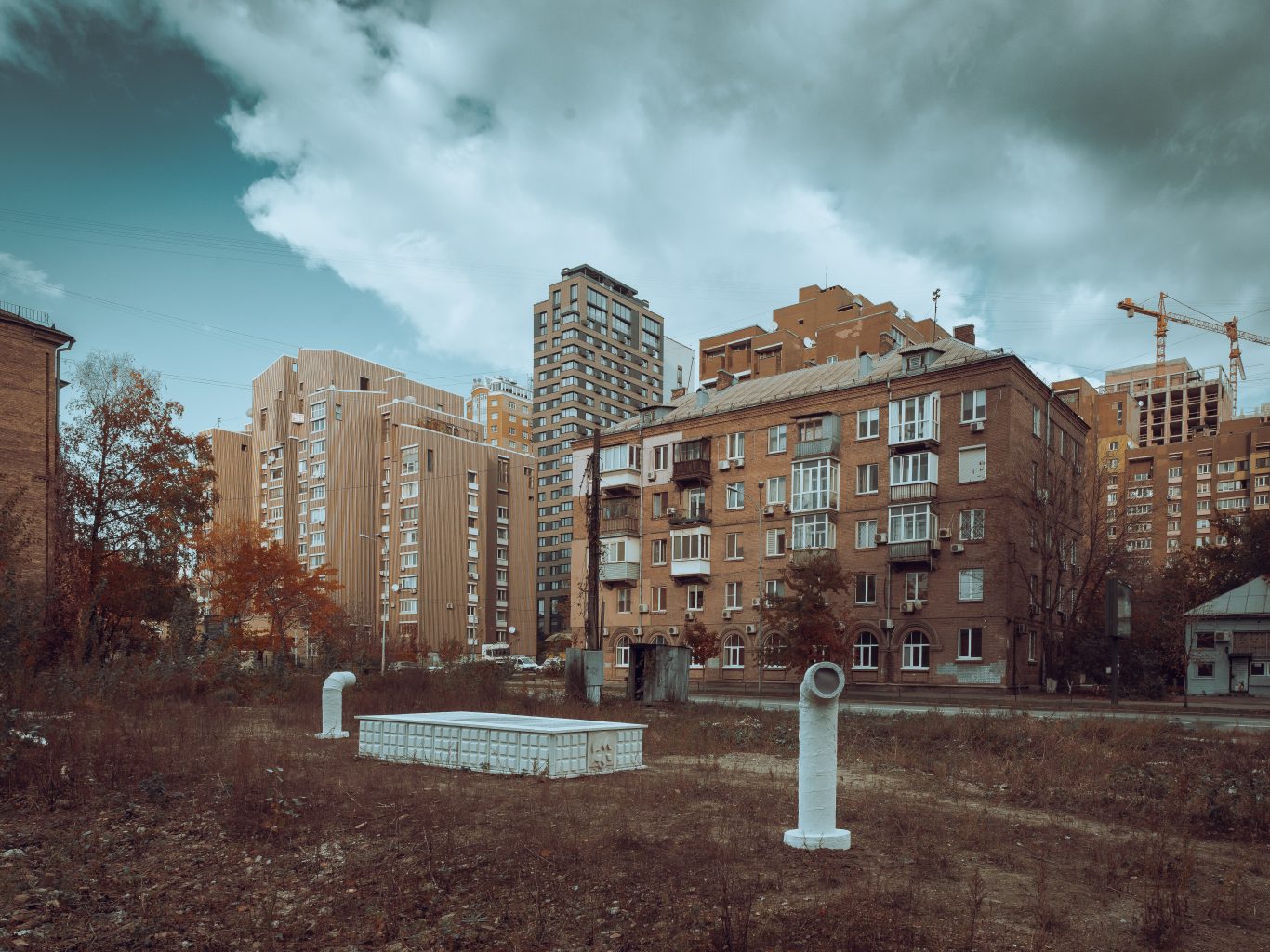
Kyiv Berlin Metro Construction ist ein Projekt der Berliner Künstler Norman Behrendt und Eric Pawlitzky. Es unterstellt eine im Bau befindliche Metro-Linie, die die jeweiligen Netze der Kyiver Metro und der Berliner U-Bahn mit einem Tunnel verbindet. Das Projekt wurde im Rahmen einer Residenz in Kyiv initiiert, wobei erste Skulptur-Entwürfe und Klanginstallationen vorgestellt wurden. Nach Präsentation der Arbeit während der „Assembly Scheme“ Ausstellung im Contemporary Art Center M17 in Kyiv möchten die beiden Künstler die Arbeit nun in die zweite Phase bringen und zusammen mit lokalen Künstlern cooperieren und Konzepte für weitere Werke dieser einzigartigen Verbindung erstellen. Ziel ist es, entlang des theoretischen Streckenverlaufs dieser Verbindung mit Stationen in Lviv, Krakow und Wroclaw multimediale Skulpturen im öffentlichen Raum zu installieren.
Die Arbeit in Kyiv
Die Arbeit an dem bildhauerischen Projekt begann im Rahmen der einmonatigen Künstlerresidenz „Ich komme und Sehe“ im Oktober 2023. Initiiert durch den deutschen Maler Paul Maciejowski und unterstützt durch die Kunststiftung NRW und die Künstlergruppe Nahirna22 wurde ein großer Atelierraum im Institute of Automation angemietet und den beiden Künstlern für ihre Arbeit in Kyiv zur Verfügung gestellt. Ausgehend von umfangreichen Recherchen, wie z.B. einer Wanderung entlang der Metrolinie M1, fertigten die Künstler in Kyiv erste Entwürfe und technische Zeichnungen für funktionale Bauwerke dieser neuen Metro-Verbindung an. Sie entnahmen Abgüsse von lokal charakteristischen Dekorelementen, wie des bekannten PO-2 Mauersegments und eines betonierten Signets der Metro Company Kyiv. Anschließend stellten Sie davon Gipsreliefs im Atelier her. Erste Entwürfe und Modelle präsentierten Sie während eines Tags der offenen Ateliers und hatten so die Möglichkeit, frühzeitig ihre Ideen mit Künstlern und Kulturschaffenden vor Ort auszutauschen. Die beiden Künstler formten einen Streckenplan als versenktes Relief und entwarfen Modelle für Lüftungsarchitekturen. Sounds der Kyiver Metro und der Berliner U-Bahn, die sie mit Field-recordings in beiden Städten aufnahmen, haben Sie zu Klanginstallationen verarbeitet, die aus den beiden Lüftungsschächten ertönen und der Arbeit eine weitere Dimension geben.
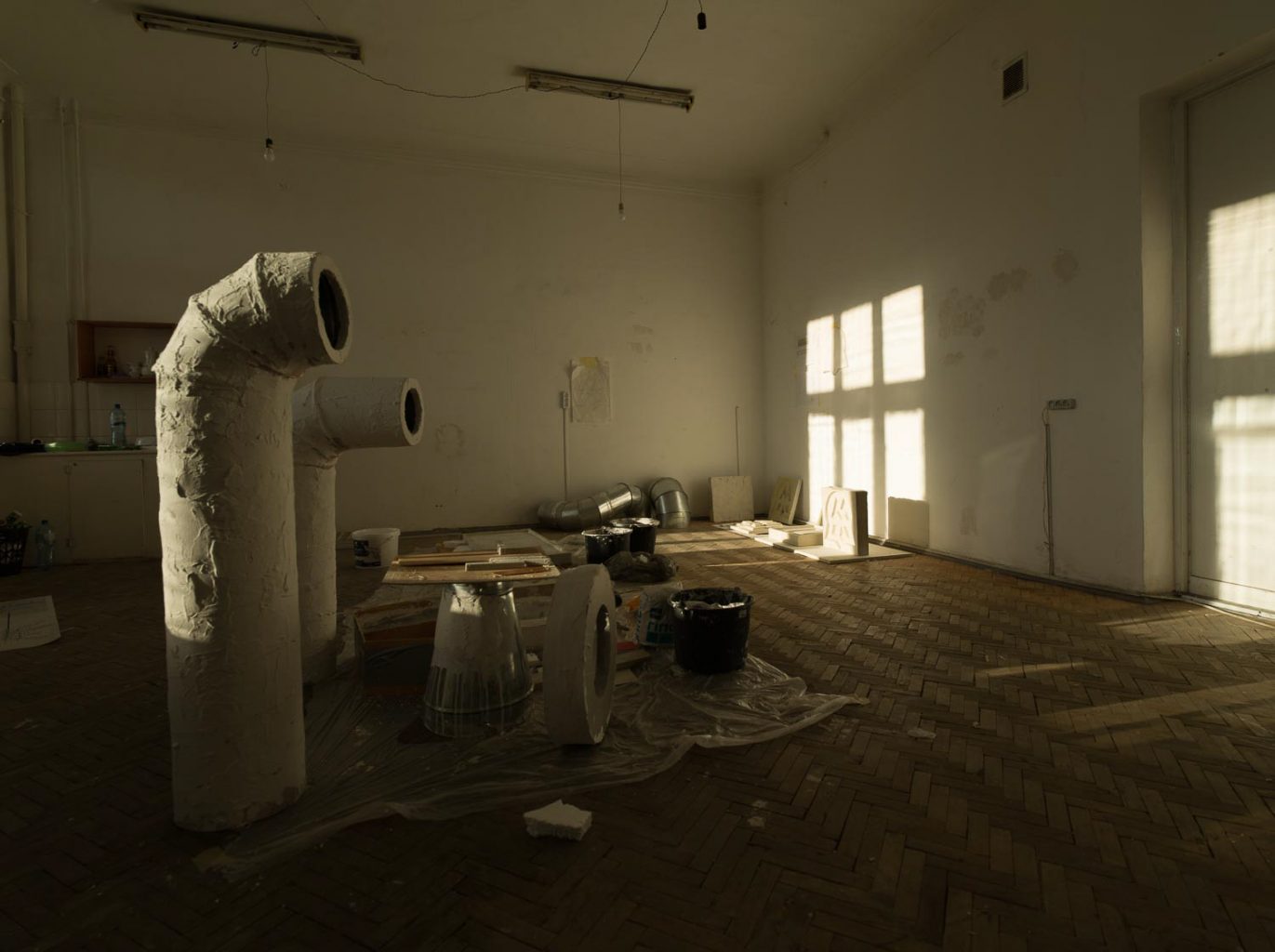
Die Arbeit wurde erstmalig am 29. Oktober 2023 zum Abschluss der Residenz auf einer Brache an der Kazymyr Malevich Straße im öffentlichen Raum von Kyiv vor Publikum präsentiert. Die Skulptur besteht aus einem Notausgang, zwei Lüftungsschächten mit zwei Klanginstallationen und einem in Gips gegossenen Metro-Plan. Zentraler Pol der Installation ist der symbolisierte Notausgang mit den Maßen 300 x 150 x 50 cm. Er besteht aus Holz, Gips, Polystyrol und Stahl und ist modular aufgebaut. Er zitiert Designelemente der Kyiver Metro und der Berliner U-Bahn und imaginiert die Existenz einer unterirdischen Linie mit fahrenden Zügen.
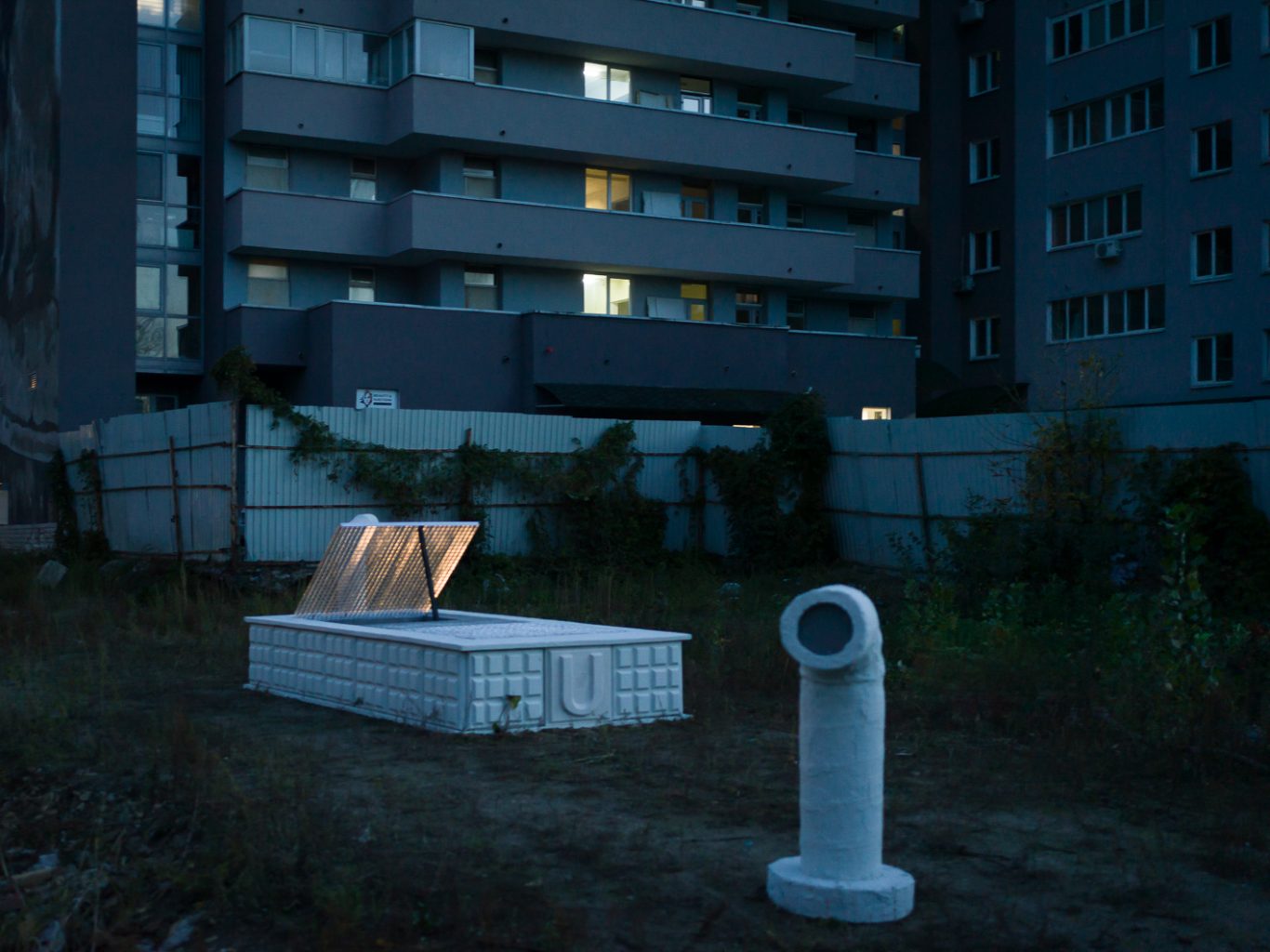
Inspiration und Vorgeschichte
Seit mehreren Jahren beschäftigt sich Norman Behrendt mit der funktionalen Architektur von Metro-
Netzwerken. Als künstlerischer Fotograf entwickelte er drei Werkgruppen in denen er intensiv die Lüftungsarchitektur der Metro in Prag (A B C Airshafts – to be released 2024 – in Zusammenarbeit mit dem lokalen Amateurfotografen David Dostalik), Warschau (unpublished) und in Berlin (Exit, 2023-24) dokumentiert.
Pawlitzky hat in seinen künstlerischen Arbeiten ebenso wie Behrendt einen Bezug zur Landschaft und zum künstlerischen Erkunden von Räumen und Distanzen. Bei ihm nahmen die Arbeiten ALLES ist WEG – Orte des 1. Weltkriegs in Polen, DIE LINIE DURCHS LAND und SEUMES WEG als Ausgangspunkt jeweils einen Bezug zu großen Territorien oder zu Extremwanderungen über lange Distanzen, die er im Kontext realisierte. Pawlitzky widmet sich nach einer umfangreichen musikalischen Ausbildung (klassische Violine, Gesang) seiner Leidenschaft für die Arbeit mit Klängen, der akustischen „Visualisierung“
fotografischer bzw. skulpturaler Arbeiten. Beide Künstler vereint ein tiefer sozialer und politischer Ansatz in ihren Arbeiten. Hervorzuheben sind hierbei Behrendts Arbeiten BLUEPRINT und ALTERNATIVE zu rechtsextremen Bewegungen sowie Pawlitzkys Serie GOOD MORNING MR. ERIC mit Porträts kenyanischer Unternehmerinnen und Unternehmer.
Inspiration fanden die Künstler in der Arbeit des Künstlers Martin Kippenberger, der mit seiner Skulpturenserie Metronet (1993-97) ein weltumfassendes Metronetzwerk visionierte und realistisch anmutende Metroeingänge an unterschiedlichen Orten der Welt umsetzte. Ebenso in der politisch hochaktuellen Arbeit A metro in Gaza von Mohammed Abusal, einem palästinensischer Künstler, der 2015 ein Netz von sieben U-Bahn-Linien vorschlägt, die die verschiedenen Gebiete des Gazastreifens miteinander verbinden sollen.
Perspektive
Behrendt und Pawlitzky verfolgen die Vision, Skulpturen im öffentlichen Raum von Kyiv, Berlin, sowie in Städten entlang des fiktiven Streckenverlaufs als permanente Installationen zu errichten. Dabei wollen sich die beiden Künstler in der Form und Gestaltung der Skulpturen Freiräume halten. So sind Recherchen zu Geschichte, Architektur und lokaler Designsprache im Vorfeld, nicht nur Teil der Recherche-Arbeit, sondern beeinflussen auch die Gestaltung und Formsprache der Skulpturen. Ziel ist es, dass das Projekt über die einzelnen Städte zusammengehörig wirkt und über ein hohes Maß an Wiedererkennbarkeit verfügt. Mittels Photovoltaik könnte nachhaltig der Strom für die Klanginstallation bereitgestellt werden. Pawlitzky und Behrendt verfolgen weiterhin die Idee mit einem/einer lokalen Künstler/in vor Ort zu kooperieren und gemeinsam ein Konzept für die finale Ausgestaltung der jeweiligen Skulptur zu entwickeln.
Die europäische Idee, übersetzt in eine unterirdische Direktverbindung zwischen beiden Städten, in der Entfernung und Grenzen keine Rollen spielen. Das Projekt visioniert ein Europa, in dem die zunehmende Kontrolle von Mobilität, die Abgrenzung von unseren Nachbarn und der Glaube, die Welt könne ein sicherer Ort sein, wenn man nur die Risiken und Unsicherheiten kontrollieren kann, Vergangenheit ist. Für beide Künstler steht bei dem Projekt, der soziale und territoriale Zusammenhalt, die Solidarität zwischen Mitgliedsländern der EU und der Ukraine als zukünftiges Mitglied und die Förderung des Fortschritts im Fokus.
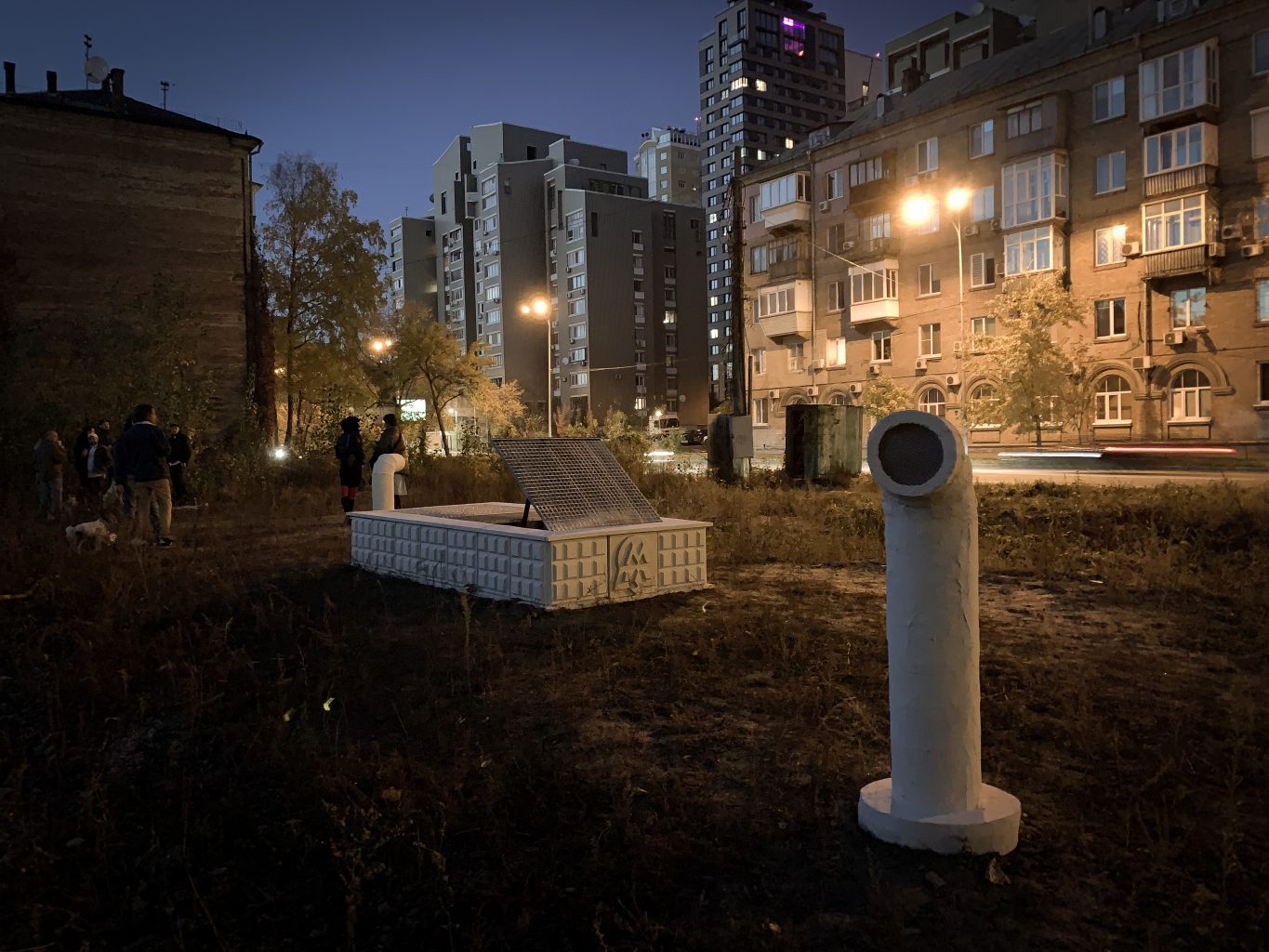
EN
In October 2023, the Berlin based artists Norman Behrendt and Eric Pawlitzky, worked on the construction of a fictitious underground metro line between Kyiv and Berlin. The aim is to create a poetic connection between the two cities.
The project was initiated as part of a one-month artist residency at the Institute of Automation in Kyiv. After presenting the work for the first time in an event in public event at Kazymyra Malevycha St in Kyiv and followed as part of the „Assembly Scheme“ exhibition at the Contemporary Art Center M17 in Kyiv, the two artists now want to bring the work into the second phase and cooperate with local artists to continue their work. The artists projection is to install sculptures in the public spaces along the theoretical route of this connection. Possible locations can be e.g. Lviv, Krakow and Wroclaw.
The work in Kyiv
The work on the sculptural project began as part of the one-month artist residency „Ich komme und Sehe“ in October 2023. Initiated by the German painter Paul Maciejowski and supported by the Kunststiftung NRW and the artist group Nahirna22, a studio space at the Institute of Automation was
rented and given to the two artists.
Based on an extensive research, such as a long walk along the M1 metro line, the artists produced initial designs and technical drawings for the functional structures of this new metro network. They took casts of locally characteristic decorative elements, such as the well-known PO-2 wall segment and a concrete signet of the Kyiv Metro Company. They then produced plaster reliefs of these in the studio. They presented their initial designs and models during an open studio day, giving them the opportunity to share their ideas with local artists and cultural workers at an early stage. The two artists formed a route plan as a sunken relief and designed models for ventilation architecture. Field recordings that they produced in both cities, were processed into sound installations that emanate from the two ventilation shafts and give the work a further dimension.
At the end of October 2023, with the completion of their residence in Kyiv, the work was presented for the first time on a wasteland on Kazymyr Malevich Street in Kyiv’s public space. The presented installation consists of an emergency exit sculpture, two ventilation shafts with a sound installation and a metro map cast in plaster. The central pole of the installation is the emergency exit sculpture measuring 300 x 150 x 50 cm. It is made of wood, plaster, polystyrene and steel and has a modular structure. The emergency exit quotes design elements of the Kyiv Metro and the Berlin U-Bahn. Together with the other parts of the installation it imagines the existence of an underground line with moving trains.
Inspiration and background
Norman Behrendt is deeply interested in the visible architecture of underground systems such as the metro. In his work practice, he vigorously maped, catalogued and sorted ventilation and emergency architecture through photography. He produced three comprehensive body of works in the cities of Prague (A B C AIRSHAFTS – to be released 2024 – in collaboration with local amateur photographer David Dostalik), Warsaw (unpublished) and Berlin (EXIT, 2023-24). Similar to Behrendt, Pawlitzky’s work practice is centered on the artistic exploration of space through walking as a method of research. In works such as
ALLES IST WEG – Orte des 1. Weltkrieges in Polen, DIE LINIE DURCHS LAND and SEUMES WEG, he translates the experience of long-distance walks through photo-texts, drawings and art books. His works speak about memories, perceptions and interpretations of history and political geographies. Trained in singing and playing violin, Pawlitzky incorporates sounds into his artistic practice. Both artists are deeply concerned with the social and political developments of our time. In the works BLUEPRINT and ALTERNATIVE, Behrendt deals with Brexit and the rise of the far right in Germany. These works talk about nationalism and xenophobia and how they play out visually on a local and global stage. They are also about contemporary image culture, the TV and internet, and the way media images are used—both consciously and unconsciously—to persuade, provoke and influence us. On the other hand, in his work GOOD MORNING MR. ERIC, Pawlitzky researches in depth the local entrepreneur scene of Kenya.
The artists found inspiration in the work of artist Martin Kippenberger, who envisioned a global metro network with his sculpture series METRONET (1993-97). Kippenberger created in different places around the world realistically-looking metro entrances and ventilation shafts that have no function. The artwork was conceived as a means of transportation for journeys in the unlimited space of imagination. Likewise, the highly topical work A METRO IN GAZA by Mohammed Abusal, a Palestinian artist who in 2015 proposed a detailed network of seven metro lines to connect the various areas of the Gaza Strip. Abusal, socially motivated, uses art to plant an idea by presenting it as if it was already normal reality. He designed his own Metro sign and went to 70 different points that are designated as train stops on his Gaza metro map, and photographed it.
Perspective
Behrendt and Pawlitzky plan to build a series of metro sculptures as permanent installations in the public space of Kyiv, Berlin and in cities along the fictitious underground line. The two artists want to retain freedom in the form and design of the sculptures. Part of their work practice is an in-depth research of the local architecture and design language that shall be translated into the formal language and material choice of the sculpture. The aim is to develop a coherent language that is recognizable throughout the chosen cities. A photovoltaic part could be used to provide sustainable electricity for the sound installation. Behrendt and Pawlitzky are also pursuing the idea of cooperating with a local artist on site and jointly develop a concept for the final design of the respective sculpture on site together to incorporate local knowledge and special features.
The European idea, translated into a direct underground connection between the cities of Kyiv and Berlin, where distance and borders play no role. The project envisions an Europe, in which the increasing control of mobility, the separation from our neighbors and the belief that the world can be a safe place, if only we can control the risks and uncertainties, will be a thought of the past. The Kyiv Berlin Metro Construction focuses on social and territorial cohesion, solidarity between EU-member states and Ukraine as a future member and the promotion of progress.